Showing Spotlights 17 - 24 of 27 in category All (newest first):
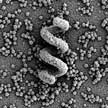 By applying concepts developed in micro- and nanorobotics, researchers demonstrate the controlled motion and delivery of cargo payloads embedded in metal-organic frameworks (MOFs). The helical MOF-based micromachine, propelled by artificial bacterial flagella, can swim and follow complex trajectories in three dimensions under the control of weak rotational magnetic fields. These swimmers are tumor-responsiv and can act as selectively automated and targeted drug delivery platforms.
By applying concepts developed in micro- and nanorobotics, researchers demonstrate the controlled motion and delivery of cargo payloads embedded in metal-organic frameworks (MOFs). The helical MOF-based micromachine, propelled by artificial bacterial flagella, can swim and follow complex trajectories in three dimensions under the control of weak rotational magnetic fields. These swimmers are tumor-responsiv and can act as selectively automated and targeted drug delivery platforms.
May 20th, 2019
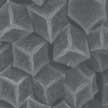 Directly carbonizing from organic precursors is the most frequently used method to prepare nanoporous carbons, widely used as electrode materials, due to its flexibility and simplicity. These materials present certain drawbacks, though, such as low surface areas, disordered structures, and non-uniform sizes, which will greatly limit their applications. However, researchers found that carbon materials derived from metal-organic frameworks (MOFs) could overcome these limitations. A review summarizes the applications of MOF-derived carbon materials.
Directly carbonizing from organic precursors is the most frequently used method to prepare nanoporous carbons, widely used as electrode materials, due to its flexibility and simplicity. These materials present certain drawbacks, though, such as low surface areas, disordered structures, and non-uniform sizes, which will greatly limit their applications. However, researchers found that carbon materials derived from metal-organic frameworks (MOFs) could overcome these limitations. A review summarizes the applications of MOF-derived carbon materials.
Feb 20th, 2019
 Scientists propose a novel tumor treatment strategy for simultaneous ablating tumor and inhibiting infection by using specially designed biodegradable metal-organic frameworks (MOFs). The strategy of simultaneous eradicating tumor tissue and inhibiting infection can inspire the researchers with novel progressing technologies for tumor therapy. This novel strategy opens the door for developing the nanomaterials that are sensitive to microwave irradiation and inhibiting infection to achieve noninvasive combined treatment in clinical practice.
Scientists propose a novel tumor treatment strategy for simultaneous ablating tumor and inhibiting infection by using specially designed biodegradable metal-organic frameworks (MOFs). The strategy of simultaneous eradicating tumor tissue and inhibiting infection can inspire the researchers with novel progressing technologies for tumor therapy. This novel strategy opens the door for developing the nanomaterials that are sensitive to microwave irradiation and inhibiting infection to achieve noninvasive combined treatment in clinical practice.
Jul 23rd, 2018
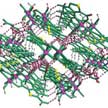 Researchers have demonstrated materials and techniques to achieve highly sensitive flexible biosensors integrated with metal-organic frameworks (MOFs) - essentially inorganic-organic hybrids that contain repeated metal ions connected with organic ligands. These high-throughput flexible devices can achieve highly specific and sensitive electrochemical detection and can be used to monitor neurotransmitters and nutrients in vivo.
Researchers have demonstrated materials and techniques to achieve highly sensitive flexible biosensors integrated with metal-organic frameworks (MOFs) - essentially inorganic-organic hybrids that contain repeated metal ions connected with organic ligands. These high-throughput flexible devices can achieve highly specific and sensitive electrochemical detection and can be used to monitor neurotransmitters and nutrients in vivo.
Jun 13th, 2018
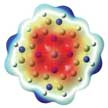 Sonodynamic therapy (SDT) has attracted wide attention as a novel treatment strategy for deep-seated tumors due to its safety, tissue penetration depth and low cost. However, traditional organic sonosensitizers tend to suffer from low water solubility, fast metabolism and elimination from the blood circulation. Sciebtists now report the excellent potential of metal-organic-framework (MOF)-derived mesoporous carbon nanostructures containing porphyrin-like metal centers in SDT augmentation.
Sonodynamic therapy (SDT) has attracted wide attention as a novel treatment strategy for deep-seated tumors due to its safety, tissue penetration depth and low cost. However, traditional organic sonosensitizers tend to suffer from low water solubility, fast metabolism and elimination from the blood circulation. Sciebtists now report the excellent potential of metal-organic-framework (MOF)-derived mesoporous carbon nanostructures containing porphyrin-like metal centers in SDT augmentation.
May 3rd, 2018
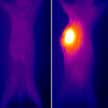 Researchers propose novel flexible Mn-doped zirconium metal-organic frameworks nanocubes for highly effective combination of microwave dynamic and thermal therapy against cancer. This is the first report of determining the microwave thermal conversion efficiency, which can be used to evaluate, compare, and predict the microwave sensitivity of different microwave-sensitive agents. More importantly, such Mn-ZrMOF nanocubes generate abundant reactive oxygen species of hydroxyl radicals under microwave irradiation.
Researchers propose novel flexible Mn-doped zirconium metal-organic frameworks nanocubes for highly effective combination of microwave dynamic and thermal therapy against cancer. This is the first report of determining the microwave thermal conversion efficiency, which can be used to evaluate, compare, and predict the microwave sensitivity of different microwave-sensitive agents. More importantly, such Mn-ZrMOF nanocubes generate abundant reactive oxygen species of hydroxyl radicals under microwave irradiation.
Jan 8th, 2018
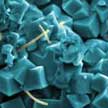 Metal-organic frameworks (MOFs) are well-ordered, lattice-like crystals. The nodes of the lattices are metals, which are connected by organic molecules. Their size-controllable nanopores, special structure and large surface area make MOFs very attractive materials for next-generation, highly sensitive gas sensors. In new work, researchers demonstrate a process that can be used for developing low-cost and highly sensitive gas sensors. By increasing the sensitivity, the amount of gas sensitive material and device size can be reduced which in turn would reduce the overall cost of the device and energy consumption.
Metal-organic frameworks (MOFs) are well-ordered, lattice-like crystals. The nodes of the lattices are metals, which are connected by organic molecules. Their size-controllable nanopores, special structure and large surface area make MOFs very attractive materials for next-generation, highly sensitive gas sensors. In new work, researchers demonstrate a process that can be used for developing low-cost and highly sensitive gas sensors. By increasing the sensitivity, the amount of gas sensitive material and device size can be reduced which in turn would reduce the overall cost of the device and energy consumption.
Nov 7th, 2017
 Molecular ferroelectrics are highly desirable as they are environmentally friendly, light-weight, and high spontaneous polarized. Though intensive studies have been focused on molecular ferroelectrics, very few researchers have tried to address the issue of thin film growth. An international research team now presents the first report on the preparation of high-quality large area MOFE films using in-plane liquid phase growth. With this approach, different kinds of novel ferroelectric films can be grown for potential practical applications such as temperature sensing, data storage, actuation, energy harvesting and storage.
Molecular ferroelectrics are highly desirable as they are environmentally friendly, light-weight, and high spontaneous polarized. Though intensive studies have been focused on molecular ferroelectrics, very few researchers have tried to address the issue of thin film growth. An international research team now presents the first report on the preparation of high-quality large area MOFE films using in-plane liquid phase growth. With this approach, different kinds of novel ferroelectric films can be grown for potential practical applications such as temperature sensing, data storage, actuation, energy harvesting and storage.
Aug 31st, 2017
 By applying concepts developed in micro- and nanorobotics, researchers demonstrate the controlled motion and delivery of cargo payloads embedded in metal-organic frameworks (MOFs). The helical MOF-based micromachine, propelled by artificial bacterial flagella, can swim and follow complex trajectories in three dimensions under the control of weak rotational magnetic fields. These swimmers are tumor-responsiv and can act as selectively automated and targeted drug delivery platforms.
By applying concepts developed in micro- and nanorobotics, researchers demonstrate the controlled motion and delivery of cargo payloads embedded in metal-organic frameworks (MOFs). The helical MOF-based micromachine, propelled by artificial bacterial flagella, can swim and follow complex trajectories in three dimensions under the control of weak rotational magnetic fields. These swimmers are tumor-responsiv and can act as selectively automated and targeted drug delivery platforms.
 Subscribe to our Nanotechnology Spotlight feed
Subscribe to our Nanotechnology Spotlight feed





